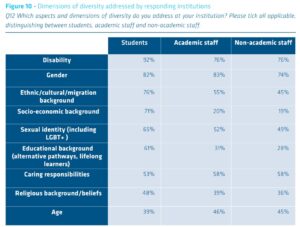The management of student data is a key piece of the puzzle of the digital transformation of universities. Well-managed data allow for monitoring of key areas of concern like retention, access and equity, exams or use of learning spaces. For learners, it is critical both for their studies as well as for their later careers that their data is available.
Student information systems and data collection
Before reaping any of these benefits, universities must have systems that allow for comprehensive and uniform data collection across the institution. Setting up such systems goes well beyond the technical challenges; it entails a change management process that fosters common ownership and understanding of the system so that data is collected and used in a coherent manner.
Student information systems are typically the core application within the institution, and it is integrated with almost everything else. For this reason, i.e. to ensure that data on aspects like learners’ achievement is always available, stability is essential. This makes it difficult to implement radical changes. Once such changes are decided, it can become a strategic project for the whole institution. A project that is not only technical in nature but also touches on defining what processes the institution needs, and how these are fit for its vision and strategy.
Prior to the Covid-19 pandemic, collecting and analysing data on the state of development and needs in different parts of the institution, including student data, was commonplace in over one third of institutions. For example, EUA found that big data were already in use in 38% of institutions in 2020, compared to 40% for learning analytics, with about half of institutions regarding both as a strategic development priority.

Limits to data collection
Moreover, there is a trade-off between fine-grained data collection and worries about privacy and surveillance. For example, data on students’ use of facilities could be very useful for managing the allocation of rooms across the university. However, if students are required to ‘check in’ when they use a room, they might find this overly intrusive in terms of monitoring of their movements. At the extreme end of data collection, emotion and attention tracking for online learning, or even in physical spaces, is certainly possible, but very likely unacceptable for both students and staff.
Reasons for low or delayed uptake of the analysis of student data through big data and learning analytics comes in part from the challenges regarding institutional culture and privacy concerns, but also from general GDPR compliance as well as other legal aspects. There is also a general fear among higher education institutions concerning the risk of commercial companies harvesting student data, for example, through platforms. Moreover, there are differences in the kinds of data that is deemed necessary or beneficial to collect. As EUA’s work on diversity, equity and inclusion shows, institutions in some countries can be very cautious about collecting data, for example, on the ethnic origin, social or religious background of learners, while in other countries this is seen as vital for monitoring and implementing social inclusion policies.

From Claeys-Kulik, A-L. e.a. (2019), Diversity, equity and inclusion in European higher education institutions, EUA
The quantity, quality and interoperability of student data is an important area. Meaningful learning analytics, in particular where there is an ambition to use artificial intelligence to investigate patterns, require a large amount of data. Moreover, if this data is used for sensitive tasks such as labelling a student as ‘at risk’ (e.g. of leaving the institution), attention must also be paid to bias in the data. This could even be a legal requirement in the EU according to the Artificial Intelligence Act (see chapter on EU Regulation). Few institutions have these kinds of large datasets, and in many places both leadership and students are worried about privacy and bias when collecting this data.
